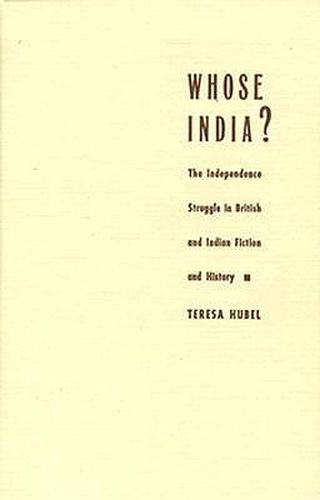Readings Newsletter
Become a Readings Member to make your shopping experience even easier.
Sign in or sign up for free!
You’re not far away from qualifying for FREE standard shipping within Australia
You’ve qualified for FREE standard shipping within Australia
The cart is loading…






For centuries, India has captured our imagination. Far more than a mere geographical presence, India is also an imaginative construct shaped by competing cultures, emotions, and ideologies. In Whose India? Teresa Hubel examines literary and historical texts by the British and Indian writers who gave meaning to the construct India during the final decades of the Empire. Feminist and postcolonial in its approach, this work describes the contest between British imperialists and Indian nationalists at that historical moment when India sought to achieve its independence; that is, when the definition, acquisition, and ownership of India was most vehemently at stake. Hubel collapses the boundary between literature and history by emphasizing the selected nature of the facts that comprise historical texts, and by demonstrating the historicity of fiction. In analyzing the orthodox construction of the British/Indian encounter, Hubel calls into question assumptions about the end of nationalism implicit in mainstream histories and fiction, which generally describe a battleground on which only ruling-class Indians and British meet. Marginalized texts by women, untouchables, and overt imperialists alike are, therefore, examined alongside the well-known work of figures such as Rudyard Kipling, Jawaharlal Nehru, E. M. Forster, and Mahatma Gandhi. In Whose India? discursive ownership and resistance to ownership are mutually constructing categories. As a result, the account of Indian nationalism and British imperialism that emerges is much more complicated, multivocal, and even more contradictory than previous studies have imagined. Of interest to students and scholars engaged in literary, historical, colonial/postcolonial, subaltern, and Indian studies, Whose India? will also attract readers concerned with gender issues and the canonization of texts.
$9.00 standard shipping within Australia
FREE standard shipping within Australia for orders over $100.00
Express & International shipping calculated at checkout
For centuries, India has captured our imagination. Far more than a mere geographical presence, India is also an imaginative construct shaped by competing cultures, emotions, and ideologies. In Whose India? Teresa Hubel examines literary and historical texts by the British and Indian writers who gave meaning to the construct India during the final decades of the Empire. Feminist and postcolonial in its approach, this work describes the contest between British imperialists and Indian nationalists at that historical moment when India sought to achieve its independence; that is, when the definition, acquisition, and ownership of India was most vehemently at stake. Hubel collapses the boundary between literature and history by emphasizing the selected nature of the facts that comprise historical texts, and by demonstrating the historicity of fiction. In analyzing the orthodox construction of the British/Indian encounter, Hubel calls into question assumptions about the end of nationalism implicit in mainstream histories and fiction, which generally describe a battleground on which only ruling-class Indians and British meet. Marginalized texts by women, untouchables, and overt imperialists alike are, therefore, examined alongside the well-known work of figures such as Rudyard Kipling, Jawaharlal Nehru, E. M. Forster, and Mahatma Gandhi. In Whose India? discursive ownership and resistance to ownership are mutually constructing categories. As a result, the account of Indian nationalism and British imperialism that emerges is much more complicated, multivocal, and even more contradictory than previous studies have imagined. Of interest to students and scholars engaged in literary, historical, colonial/postcolonial, subaltern, and Indian studies, Whose India? will also attract readers concerned with gender issues and the canonization of texts.